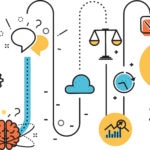What can the world of banking learn from design thinking?
The rapid pace of development witnessed in 21st century civilization has turned many a world upside down. Disruptive products, services and technologies continue to manifest at an almost unfollowable rate, while societies and markets exhibit increasing magnitudes of complexity.

Once straightforward actions – interacting with each other, procuring information, using money – are now facilitated by an array of technologies. People chop and choose between these technologies as if they were brands of cereal: ‘What app shall I try out this week?’ ‘I’ll have to delete something else to make space on my phone, first.’
In such a complex world, where consumer, market and industry dynamics are constantly shifting, how can the banking sector keep pace? How can it ensure the services, products and experience it provides evolve with the needs and expectations of the 21st century individual?
From Aristotle and Galileo to Albert Einstein and Steve Jobs, great thinkers throughout history have borrowed great ideas. Being original is not a prerequisite of being creative or successful – most innovation is driven by people who have stolen an idea, principle or concept from elsewhere and then applied it to their industry. To meet the challenges presented by the digital age, that is exactly what the banking sector must accomplish today.
This is why we at BBVA are encouraging our staff – across all functions, departments and job titles – to start thinking like designers.
Even if you don’t know what design thinking is, you probably associate it with creative organizations, design firms, advertising agencies, or tech startups, rather than financial institutions like BBVA. Design thinking does originate from those industries. But it’s an intrinsically human process that calls into play a number of aptitudes we all posses, but is often overlooked thanks to more conventional problem solving strategies.
When designers look at a problem, like, how to arrange an office to maximise collaboration between employees, they start not with plans and designs and theory, but with people. Specifically, the people who will interact with the final design. In the case of the office, that’s the employees: What kind of people are they? Do they have specific needs? What are their working schedules? Do they go out for lunch or shake crumbs from their keyboard at the end of each week?
From a wider perspective, the use of this methodology affords both organizations and people a powerful advantage. Design thinking is like an instrument that can take society’s temperature – and then report back on the way people are thinking and behaving. Such reports act as a rope that helps business remain upright in the ever shifting sands of 21st century market dynamics.

Design thinking comprises four stages. To begin utilising this cognitive technique, professionals and organizations must follow each in order.
1. Understanding
To create a product that people actually want to use, you must first understand the people who you want to use it. Don't think of the user as a customer, but as a human being; a person who has agency, who moves and lives in a particular context, and who has a series of needs that can be satisfied.
It’s only when you know the needs of the people you’re serving, can you truly begin to define the problems that are getting in the way – the core problems that are stopping them from satisfying their needs. A Journey Map is a great way to identify and strategize for key moments in the product, experience, or service you’re designing. Working with the concept of the user’s key moments helps everyone to visualize the customer’s experience from beginning to end - maintaining a human-centred approach.
2. Ideation
With this solid background in place you can begin to add the creative flourishes to your canvas – to look for new solutions that might tackle the problem at hand. Imagination is the basis of creativity, so it’s important to ideate in an environment in which problem-solvers feel comfortable saying stupid things. All ideas are valid, and stimulating free thinking increases the field of competition– the more potential solutions you have, the more likely you are to find one that aces the problem.
3. Prototyping
This is an experimental phase, where you create a succession of scaled-down beta versions of your product or service. Your solutions are integrated into the prototypes. One-by-one they are investigated and either accepted, improved and re-examined, or rejected on the basis of user feedback. The aim is to identify potential; which of the prototypes best solves the problems you identified in the first three stages? Which of the prototypes is it most worth putting all of your resources behind?
4. Evaluation
Once you pick your best prototype, you can begin working towards perfecting it. Evaluating is measuring, so collecting data both qualitative and quantitative will be extremely useful during this stage. Which version of your prototype works best? What are the ramifications of its continuous, long-term use? Does it create unforeseen problems that require the development of new solutions?
Design thinking does not end. Think of the iPhone – a new version comes out every year, and operating system updates land, at the very least, quarterly. Even when a product is launched, the most successful businesses continue to develop it using the four steps above. This is the most important lesson of design thinking: remain vigilant at all times and never, ever, stop thinking about your user.
If you’d like to learn more about design thinking, life and career opportunities at a company that is leading the way for 21st century banking, please visit BBVA Careers and follow us on LinkedIn.